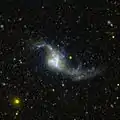NGC 1487
NGC 1487 is an irregular galaxy[3] in the constellation Eridanus. It was discovered by James Dunlop on Oct 29, 1826.[4]
| NGC 1487 | |
|---|---|
 Hubble Space Telescope image of NGC 1487 | |
| Observation data (J2000 epoch) | |
| Constellation | Eridanus |
| Right ascension | 03h 55m 46s[1] |
| Declination | −42° 22′ 01″[1] |
| Redshift | 0.002829[2] |
| Helio radial velocity | 848 ± 1 km/s[2] |
| Apparent magnitude (V) | 11.68[1] |
| Apparent magnitude (B) | 12.28[1] |
| Characteristics | |
| Type | Pec[2] |
| Other designations | |
| NGC 1487, MCG-07-09-002, LEDA 14117[1] | |
It is thought to be the remnant of two galaxies, which are the components NGC 1487E and NGC 1487W, that collided about 500 million years ago.[5]
See also
Gallery
 NGC 1487 by GALEX
NGC 1487 by GALEX
References
- "NGC 1487". SIMBAD. Centre de données astronomiques de Strasbourg. Retrieved 19 June 2019.
- "NASA/IPAC Extragalactic Database". ned.ipac.caltech.edu. Retrieved 19 June 2019.
- E.L. Aguero, S. Paolantonio. "The Peculir Galaxy NGC 1489". SAO/NASA Astrophysics Data System (ADS).
- Seligman, Courtney. "New General Catalog Objects: NGC 1450 - 1499". New General Catalog Objects: NGC 1450 - 1499. Retrieved 19 June 2019.
- Mullan, B.; Konstantopoulos, I. S.; Kepley, A. A.; Lee, K. H.; Charlton, J. C.; Knierman, K.; Bastian, N.; Chandar, R.; Durrell, P. R.; Elmegreen, D.; English, J.; Gallagher, S. C.; Gronwall, C.; Hibbard, J. E.; Hunsberger, S.; Johnson, K. E.; Maybhate, A.; Palma, C.; Trancho, G.; Vacca, W. D. (2011). "Star Clusters in the Tidal Tails of Interacting Galaxies: Cluster Populations Across a Variety of Tail Environments". The Astrophysical Journal. 731 (2): 93. arXiv:1101.5393. Bibcode:2011ApJ...731...93M. doi:10.1088/0004-637X/731/2/93.
External links
 Media related to NGC 1487 at Wikimedia Commons
Media related to NGC 1487 at Wikimedia Commons
- NGC 1487 on WikiSky: DSS2, SDSS, GALEX, IRAS, Hydrogen α, X-Ray, Astrophoto, Sky Map, Articles and images
This article is issued from Wikipedia. The text is licensed under Creative Commons - Attribution - Sharealike. Additional terms may apply for the media files.